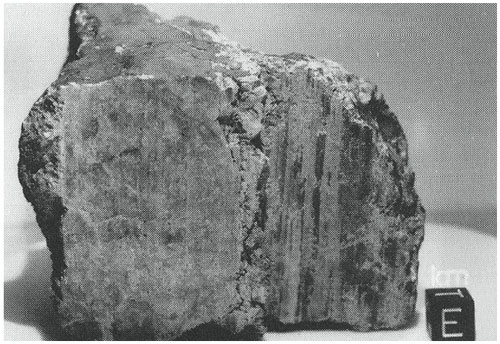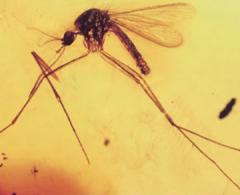
This Article From Issue
July-August 2006
Volume 94, Number 4
Page 375
DOI: 10.1511/2006.60.375
The Rock from Mars: A Detective Story on Two Planets. Kathy Sawyer. xii + 394 pp. Random House, 2006. $25.95.
When it comes to telling stories, science writers and scientists are at a disadvantage in that, unlike novelists (who are free to create their own reality), they must reconstruct events accurately. But once in a great while, science offers up a tale as compelling as any found in fiction and someone comes along who is equipped to tell it well. In The Rock from Mars, journalist Kathy Sawyer realizes the full potential of a great science story in all its multidimensional complexity and richness.

From The Rock from Mars.
The rock here is meteorite ALH84001, named for the place in Antarctica (Allan Hills) and the year (1984) it was found. Sawyer's account encompasses the details of the rock's discovery, the painstaking analysis that revealed its Martian origins, the surprising suggestion that it might contain evidence of past (fossil) life on Mars, the high-level political ramifications of that revelation, and the media frenzy and scientific firestorm that ensued. The book doesn't focus exclusively on the hot topics of extraterrestrial life and the origin of life on Earth; Sawyer manages to work in crucial information on geology, planetary science, meteoritics, biochemistry, microbiology, geochemistry and microscopy.
Going beyond the tough-enough task of popularizing scientific material, Sawyer includes realistic, credible descriptions of how scientists work and interact. Her biographical vignettes of the researchers investigating ALH84001 offer insight into how their personal lives affected, and were affected by, their scientific roles. She clearly got to know these players well, and in the course of covering their discoveries for the Washington Post, she presumably observed some of the action firsthand. I have no way of knowing whether the details she includes about people's personal interactions and feelings are correct in every particular, but she captures the social milieu of science perfectly. ALH84001 is one of several meteorites that are generally acknowledged to have come from Mars because they contain trapped gases that match the Martian atmosphere. David McKay, a geologist at NASA's Johnson Space Center, assembled a team that discovered in the rock a variety of surprising characteristics at a microscopic level. They found carbonates suggestive of liquid water flow on Mars at the time they formed, organic substances usually associated with life, bits of magnetite similar to the "compasses" found in some bacteria, and tiny structures within the carbonates that were reminiscent of forms of microorganisms on Earth.
These findings were based on meticulous studies, and the scientific papers that McKay's team prepared concentrated on the hard results, with a cautious suggestion regarding implications for life on Mars. However, no amount of caution could control how the story would be told by others.
When the Administrator of NASA, Daniel Goldin, was told about the findings of McKay's group, he quickly grasped the scientific issues. A major aspect of his job was to then sort out how to handle the information—to decide who needed to know immediately (President Clinton) and what preparations should be made for public release.
The political story is riveting, and involves events and people familiar to the general public. The book's publishers want you to know that ALH84001 brought down Bill Clinton's spin doctor Dick Morris, because of what Morris leaked to a $200-an-hour call girl. A sex scandal in the Clinton administration still sells. However, Sawyer does show, with insider descriptions of meetings and discussions, how seriously the rock affected the Clinton White House. From the perspective of the 21st century, I gasped when reminded that we once had leaders with such understanding and intellectual curiosity.
The first article from McKay's team suggesting that the meteorite contained fossil life ("possible relic biogenic activity") was slated to appear in Science on August 16, 1996. But news about the discoveries began to leak out the week before, so the fateful press conference at which McKay and his colleagues explained their discoveries was moved up.
The ALH84001 story is a case study of the role of public relations in the operations of modern institutions. The Dick Morris connection is one example. Most eye-opening, and described in detail, was the interaction between the public relations staffs at NASA and at the American Association for the Advancement of Science (which publishes Science) leading up to the press conference. Insight into the NASA press office is especially timely considering its recent alleged attempt to stifle discussion of global warming.
In showing how publicity considerations are crucial to agency management, Sawyer not only departs from the official NASA story line offered by the PR people, but she turns it inside out. We see how the public handling of scientific results can affect the research process itself.
Sawyer's account also offers insight into NASA's culture in the early 1990s. According to her, the agency at that time was "an engineering organization built on the bedrock of politics, with a pork barrel perpetually rolling through"—a place with great credibility problems, where there was no correlation between scientific merit and grant allocations or other rewards. She shows how the ALH84001 research affected NASA's organizational vision, enhancing somewhat the stature of science within the agency and leading to an emphasis on biological origins. Now the Bush administration is trying to reverse that change and slash NASA's astrobiology program.
Because of its subject matter, the work of McKay and his colleagues would have been explosive no matter how much they had downplayed it. Sawyer correctly notes that leaps of imagination have always been a key part of the real scientific method. But those leaps are dangerous to the people making them, something that McKay and his team members knew as they integrated their several lines of evidence into a dramatic hypothesis.
The acrimony started early, when NASA invited a designated skeptic—paleobiologist William Schopf—to participate in the press conference about the 1996 paper in Science. The idea was for an outsider to provide critical caveats about the work. Over the following years, many other scientists took sides, and positions became entrenched as the level of virulence rose.
Sawyer does a nice job of summarizing the scientific issues and the personal positions of the many players. She describes Schopf as being thoughtful about the importance of questioning authority in science. Indeed, he had made his name by challenging the canonical belief that life on Earth originated not long before the Cambrian period. He had found what he believed to be microfossils of organisms almost 3.5 billion years old. His contention regarding ALH84001 was that it was missing the clear biological cell structures he saw in his own pre-Cambrian rocks. So at the press conference, he was cast in an unaccustomed role: He was the authority resisting a new idea.
Ironically, Schopf eventually found himself defending his own famous discovery of early life on Earth against charges similar to those he had raised about the work of McKay's group. Not everyone is convinced that Schopf's microscopic forms are fossils. That battle came to a head during a debate between Schopf and a critic of his work, Martin Brasier, at NASA's 2002 Astrobiology Conference. Sawyer reports that afterward, "a Washington Post reporter" asked Schopf whether he thought he was now in the position in which he had put David McKay back in 1996. Was that reporter Sawyer, developing material for this book?
The venue for that debate was significant: Before the mid-1990s, who would have thought that the origins of life on Earth would have been within the agency's purview, let alone central to its mission? Sawyer makes a convincing case that the rock from Mars was the catalyst for this transformation.
McKay and his colleagues had done careful research, made major discoveries and proposed a daring hypothesis. Many, but not all, of their claims were borne out by further investigation. Sawyer says that ultimately the McKay group conceded that "some (though not all) of the wormlike microfossil shapes" in the rock "seemed to be bits of naturally formed clay or ridges of mineral," and that "the rock was . . . loaded with Earth-born contaminants that apparently had seeped in with Antarctic meltwater." Nonetheless, in many ways the group's work transformed scientific and institutional thinking.
They paid heavily for it. What they had to endure is described, with surprising frankness, by one of their detractors, who is quoted in the chapter titled "At Daggers Drawn" as saying that the McKay group "felt that they were being mistreated when in fact they were being treated with the same contempt [as] . . . anybody that would try and shake up the current paradigm." Apparently contempt is viewed as a perfectly normal and appropriate response to anyone who thinks outside the box.
Scientific trailblazers are routinely treated roughly. For the scientific community, there is value to sticking with a paradigm until it is definitively proven wrong. As Sawyer says, the scientific process eventually brings out the truth: "What kept the process honest and fruitful, in the end, would be the collective interactions of the tribe of interested scientists."
In the long run that is true. But should creativity and innovation be rewarded with contempt? Scientists may smugly believe that any worthy player will tough it out. Indeed, people like Schopf and the members of McKay's team have been tough enough to play the game, although doing so takes an emotional toll. The problem is that we do not know what science is losing in the process. What does a young, talented person make of a profession that rewards initiative, care and creativity with contempt? How many are driven to more sensible career choices?
Anyone who is contemplating a career in science, who wants to understand what scientists do, who is curious about where scientific knowledge comes from, or who is interested in life, the universe and everything should read this book.

American Scientist Comments and Discussion
To discuss our articles or comment on them, please share them and tag American Scientist on social media platforms. Here are links to our profiles on Twitter, Facebook, and LinkedIn.
If we re-share your post, we will moderate comments/discussion following our comments policy.